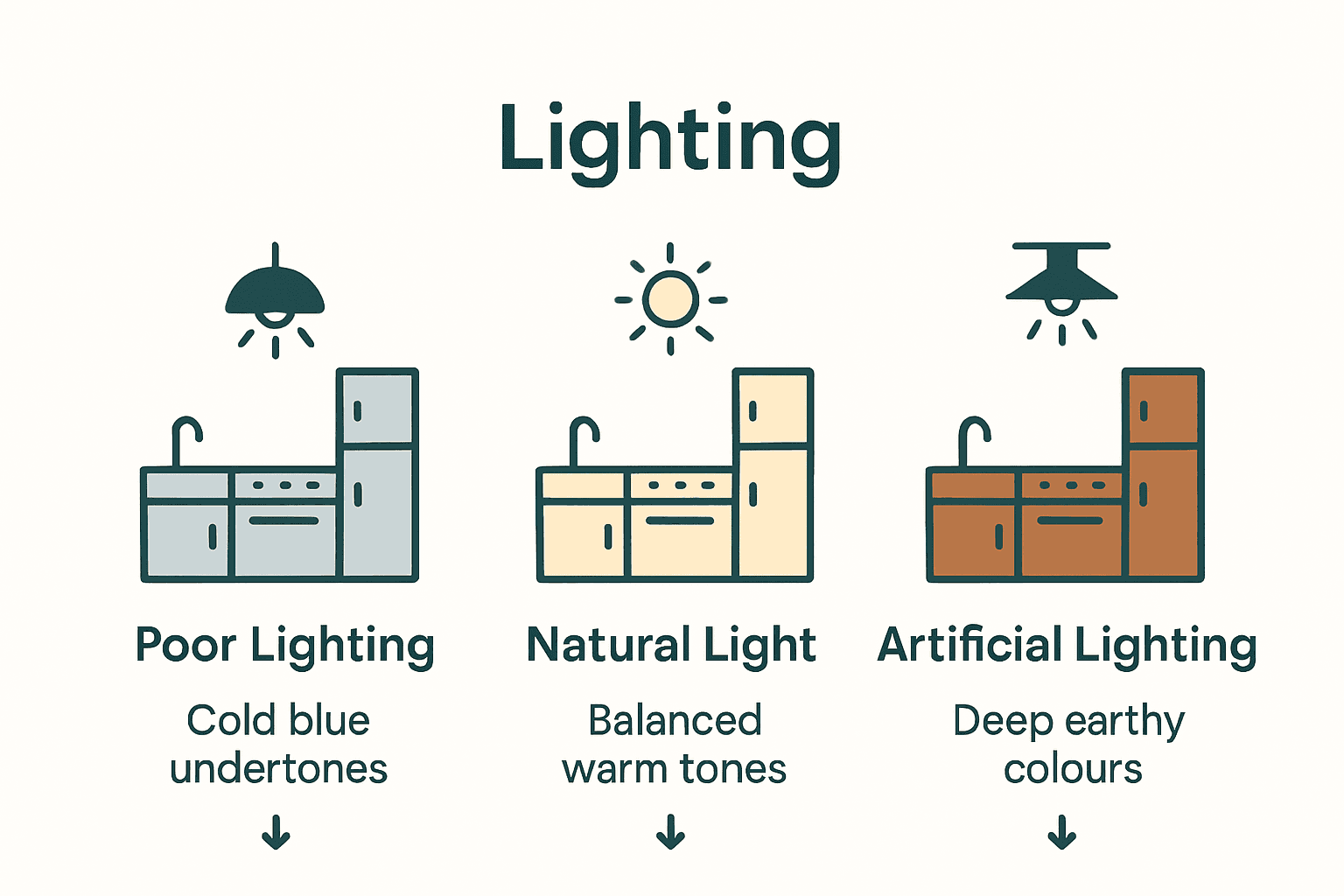How Colour Affects Kitchen Design: Complete Guide
Colour does more than decorate a kitchen—it can shape your mood every time you walk in the door. Studies show that choosing the right colours can boost feelings of comfort or even spark creativity during daily routines. With so many shades and combinations available, understanding colour influence becomes key to creating a kitchen that feels both welcoming and personal. This guide sets out the principles, trends, and practical tips to help you harness colour’s true potential.
Table of Contents
- Defining Colour Influence In Kitchen Design
- Psychological Effects Of Colour Choices
- Popular Kitchen Colour Trends In The UK
- Impact Of Lighting On Colour Perception
- Practical Tips For Kitchen Respraying
- Common Colour Mistakes To Avoid
Key Takeaways
| Point | Details |
|---|---|
| Colour Psychology | Kitchen colours significantly affect emotions and experiences, making thoughtful selection essential for creating desired atmospheres. |
| Trends in Colour | UK kitchen design is shifting towards expressive colours like sage green and deep navy, emphasizing emotional engagement over minimalism. |
| Lighting Impact | Lighting fundamentally alters colour perception; selecting hues that complement natural light can enhance the kitchen’s ambiance. |
| Common Mistakes | Avoid relying solely on light colours or high-shine finishes, which can lead to unwelcoming or impersonal kitchen environments. |
Defining Colour Influence in Kitchen Design
Colour is far more than a visual aesthetic in kitchen design – it’s a powerful psychological tool that transforms spaces and influences emotional experiences. According to fcilondon, different kitchen colours can dramatically alter the atmosphere, creating specific moods and perceptions that extend beyond mere decoration.
Understanding colour theory becomes crucial when designing kitchens. As davidlislekitchendesign explains, this involves exploring primary, secondary, and tertiary colours, and learning how to create harmonious colour schemes through strategic combinations. Complementary, analogous, and triadic colour approaches each offer unique ways to craft visually compelling kitchen environments.
Key considerations when selecting kitchen colours include:
- Psychological impact of warm versus cool tones
- Natural light exposure in your kitchen space
- Size and layout of your kitchen
- Existing architectural elements and fixtures
- Personal emotional response to different colour palettes
The right colour strategy transforms a kitchen from a mere functional space into an emotionally resonant environment that reflects personal style and enhances daily living experiences. Learn more in our comprehensive guide on kitchen paint selection.
Psychological Effects of Colour Choices
Colour isn’t just a visual element – it’s a powerful psychological trigger that can dramatically transform how we experience and interact with our kitchen spaces. Livk reveals that different colours can evoke specific emotional responses and dramatically influence our psychological state, making colour selection far more nuanced than simple aesthetic preference.
Emotional resonance plays a critical role in kitchen design. Warm colours like red and orange tend to stimulate appetite and create energy, making them excellent choices for social cooking spaces. In contrast, cool tones such as blue and green can induce feelings of calm and tranquillity, potentially making them ideal for kitchens that double as relaxation zones. Yellow hues often introduce feelings of optimism and brightness, while neutral colours provide a sense of balance and sophistication.
Understanding the psychological implications of different colour palettes allows homeowners to craft intentional kitchen environments. Consider these strategic colour applications:
- Red: Stimulates conversation and increases energy
- Blue: Promotes calmness and reduces stress
- Green: Creates a sense of freshness and renewal
- Yellow: Generates feelings of happiness and creativity
- Neutral tones: Offer flexibility and timeless elegance
The art of selecting kitchen colours goes beyond mere decoration – it’s about creating an environment that resonates with your emotional needs and lifestyle.
Explore our comprehensive kitchen paint finish guide to discover how subtle colour choices can transform your culinary space.
Popular Kitchen Colour Trends in the UK
The UK kitchen design landscape is experiencing a vibrant transformation, moving beyond traditional neutral palettes towards more expressive and emotionally engaging colour choices. Marie Claire highlights the emergence of ‘Dopamine Decor’, a trend that embraces bold colours and joyful aesthetics to create emotionally uplifting spaces that challenge previous minimalist design approaches.
Grey continues to maintain its stronghold in kitchen design, but with a nuanced evolution. Ideal Home reveals that contemporary grey kitchens are no longer about stark, cold tones, but rather sophisticated, layered approaches that incorporate warmth and texture. Homeowners are now selecting grey shades that complement natural elements, creating spaces that feel both modern and inviting.
Current UK kitchen colour trends showcase a diverse and dynamic palette:
- Sage Green: Bringing natural, calming elements indoors
- Deep Navy: Adding depth and dramatic sophistication
- Warm Terracotta: Introducing earthy, Mediterranean-inspired tones
- Soft Blush: Creating gentle, contemporary elegance
- Rich Charcoal: Providing a bold, sophisticated alternative to traditional greys
The key to successful kitchen colour design lies in balancing personal expression with timeless appeal. Explore our smart kitchen decorating ideas to discover how to incorporate these trending colours into your culinary space.
Impact of Lighting on Colour Perception
Lighting is a transformative element that can dramatically alter how we perceive colour in kitchen spaces, turning seemingly straightforward design choices into complex visual experiences. Ideal Home emphasises the critical importance of understanding how different lighting conditions can fundamentally change the appearance and emotional resonance of colour selections.
Natural light exposure plays a pivotal role in colour perception, with north-facing kitchens presenting unique challenges. Certain undertones can significantly impact the room’s atmosphere – blue, grey, and violet undertones can create a cool, potentially unwelcoming environment. Smart designers recommend selecting warmer neutrals that can counteract these potentially harsh lighting conditions, creating more inviting and comfortable spaces.

For kitchens with limited natural light, strategic colour selection becomes crucial:
- Warm whites: Brighten and expand perceived space
- Moody greens: Add depth and sophistication
- Inky blues: Create dramatic, intimate atmospheres
- Mushroom and taupe tones: Provide subtle warmth
- Earthy reds and browns: Introduce rich, comforting elements
- Mellow yellows: Inject cheerful, luminous qualities
Learn more about paint selection for challenging kitchen spaces to master the art of transforming your kitchen’s visual perception through intelligent colour and lighting choices.
Practical Tips for Kitchen Respraying
Kitchen respraying is a cost-effective and transformative approach to updating your kitchen’s appearance without the expense and disruption of a complete renovation. The process requires careful preparation, precise technique, and strategic planning to achieve professional-looking results that can dramatically enhance your kitchen’s aesthetic appeal.
Surface preparation is the cornerstone of successful kitchen respraying. This involves thoroughly cleaning surfaces, repairing any imperfections, and creating a smooth base that will allow the new paint to adhere perfectly. Critical steps include degreasing cabinets, sanding down existing finishes, filling minor scratches or dents, and ensuring a completely dust-free environment before beginning the spraying process.
Key considerations for a successful kitchen respray include:
- Selecting the right type of paint for different kitchen surfaces
- Investing in professional-grade equipment
- Protecting surrounding areas from overspray
- Choosing colours that complement your kitchen’s existing design
- Understanding the curing time for different paint types
- Ensuring proper ventilation during the respraying process

Discover our comprehensive guide to kitchen respray best practices to transform your kitchen with professional-quality results that will revitalise your space and protect your investment.
Common Colour Mistakes to Avoid
Choosing the right colours for your kitchen is a delicate art that can make or break the entire design aesthetic. Ideal Home reveals critical pitfalls that homeowners frequently encounter when selecting colours, highlighting how seemingly minor decisions can dramatically impact the overall look and feel of the space.
Lighting and undertones play a crucial role in colour perception, particularly in challenging spaces like north-facing kitchens. Ideal Home warns against using hues with blue, grey, or violet undertones that can create an uninviting, cold atmosphere. These cool undertones can make a kitchen feel sterile and unwelcoming, especially in spaces with limited natural light.
Common colour mistakes to steer clear of include:
- Relying exclusively on light colours without adding texture
- Using high-shine finishes that create a clinical, impersonal feel
- Avoiding bold colours out of fear
- Ignoring the impact of natural and artificial lighting
- Failing to consider the kitchen’s orientation and natural light exposure
- Choosing colours that clash with existing architectural elements
Explore our guide to kitchen painting techniques to ensure you make informed colour choices that transform your kitchen into a vibrant, inviting space.
Transform Your Kitchen with the Power of Colour and Professional Respraying
Choosing the perfect kitchen colours can feel overwhelming. The article highlights how lighting, undertones, and emotional impacts can make a huge difference to your space. It’s easy to worry about making costly mistakes or ending up with a colour that drains the warmth from your kitchen. You want a kitchen that feels inviting, energising, and truly reflects your style without the disruption of a full renovation. That’s where our expert kitchen respray service steps in.

At SKR Specialists we bring your colour vision to life with a flawless finish done in situ, so you can enjoy a transformed kitchen quickly and easily. Discover more inspiring ideas and expert guidance in our Uncategorized Archives or explore how professional respraying can protect your investment while refreshing your kitchen’s vibe. Take the first step towards a warm, welcoming kitchen that truly feels like home by visiting our main website today.
Frequently Asked Questions
How does color impact the mood in a kitchen?
Color can significantly influence mood; for instance, warm colors like red and orange stimulate appetite and energy, while cool colors such as blue and green promote calmness and tranquility.
What are the best color combinations for kitchen design?
Harmonious color schemes can be achieved through complementary, analogous, or triadic color approaches. Experimenting with primary, secondary, and tertiary colors can lead to visually compelling designs.
How does lighting affect the perception of kitchen colors?
Lighting plays a crucial role in how colors are perceived. Natural light exposure can alter the appearance of color, and different lighting conditions can either enhance or diminish certain hues, making color selection essential.
What are common mistakes to avoid when choosing kitchen colors?
Common mistakes include overlooking the impact of lighting, using colors with harsh undertones, and relying solely on light colors without balancing them with texture or bold accents.
